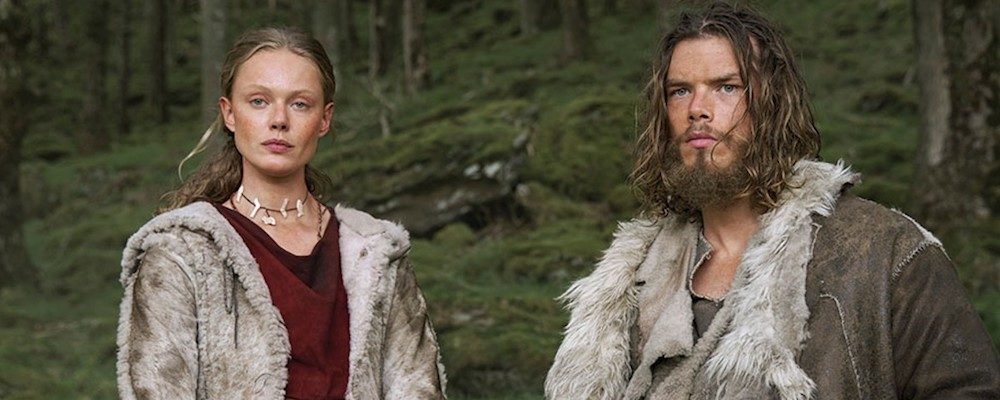Netflix’s ‘Vikings: Valhalla’ Delivers the Blood-Soaked Goods
Alci Rengifo
There are certain things one expects as a viewer when venturing into a TV show that has to do with Vikings. We expect lots of rain, mud, ripped actors wielding enormous weapons, blond Valkyries and over-the-top dialogue. Netflix’s “Vikings: Valhalla” delivers all of this to the hilt. If these things are not your cup of tea, move on to something else. In many ways this is an intriguing kind of fan service. The show is a sequel of sorts to the surprise History Channel hit “Vikings,” originally created by Michael Hirst, a longtime guru of historical dramas ever since “The Tudors.” Hirst is back as producer of this new saga which uses a few true facts as an excuse for blood-soaked battles and wide vistas set in cold, European locales.
The action is set about 100 years after the events of “Vikings” and the rise of king Ragnar Lodbrok (Travis Fimmel). It’s the year 1002 and the Vikings are facing literal genocide. English King Aethelred (Bosco Hogan) has ordered the slaughter of every Dane on the island as retaliation for years of the Vikings raiding and looting. To respond to this provocation, Viking King Canute (Bradley Freegard) assembles a vast army at Kattegat. The plan is to wage war on Aethelred to avenge their dead comrades and do all the other berserker things Vikings are required to do. Also arriving at the big base camp are Harald Sigurdsson (Leo Suter) and Olaf “the Holy” Haraldsson (Jóhannes Haukur Jóhannesson), who has converted to Christianity and become quite the zealot. Joining the pack is a real Viking from history, Leif Eriksson (Sam Corlett), son of the legendary Erik the Red (believed by some historians to have beaten Columbus to America). Leif isn’t here just to join the coming war; he’s accompanied by warrior sister Freydis (Frida Gustavsson). Their prime reason for being here is to seek revenge on a Christian Viking who raped Freydis.
As expected, “Vikings: Valhalla” has the freedom to be a little bloodier than its History Channel predecessor. Aside from slightly extra gore, fans of the original will feel right at home. The visual style, tone and storytelling techniques remain intact. Opening shots introduce us to Leif and Freydis as they endure a massive storm at sea, yelling through wind and rain, reminiscent of forgotten Vikings flicks like “The 13th Warrior.” Sometimes the show can even take a bit too long to get to the story, because it urgently wants to deliver some action. The slaughter that initiates the plot, known in history as the St. Brice’s Day Massacre, drags on a bit too much with endless shots of men with shields and flying arrows. But that is what the intended audience no doubt expects. Part of what made “Vikings” appealing was also its taste for getting trippy, from the ads to episodes themselves. “Valhalla” also goes for hallucinatory visuals like painted men dancing with snakes at grand, mug-clinking gatherings.
A show like this tends to struggle with characters and that is the weakest part of “Vikings: Valhalla.” The writing has fun making references to history and the clash between the old pagan world and Christianity, but the only truly engaging personality is Freydis, played by Frida Gustavsson who also gives the best performance in the ensemble. She’s a fierce warrior but also vulnerable and emotionally traumatized by the attack she now seeks to avenge. A constant reminder of her experience is how her attacker left a cross carved on her back. Freydis will get to do the same in one of the first brutal moments of the season where she carves a new cross into the chest of an unlucky Viking jerk. Epics need lots of sexual tension as well. Freydis is soon being pined for by Harald, who is turned on by her strength. Naturally the two do have some romps in bed where grand lines are crisscrossed with revelations about each other’s personal histories.
The other engaging angle to the plot is one familiar to most stories set in this time period, mainly how the old pagan world began to be usurped by Christianity. While the Vikings are united against the English, their own camp is divided between zealous followers of the Christian faith and those still clinging to the old ways. There is a lot of subtext about religious fanaticism surrounding Olaf, who refuses to fight alongside pagan Vikings because of their wicked ways. He’s blind to how his clan is as brutal and cruel as everyone else. Like all zealots, he threatens to divide the Viking army because he’s certain his beliefs are correct and everyone else is wrong. Christian Vikings are distinguished by wearing crosses, a smart visual touch to help us keep track of who’s on what team. Theological arguments are not the main drive to enjoying a show like “Vikings: Valhalla,” it’s more about the vendettas and long-haired men brawling in camps, pounding each other while sporting man buns more appropriate for west Los Angeles. This show is like an appetizer before Robert Eggers releases his long-awaited “The Northmen” later this year. Until then, “Valhalla” hits the spot for a testosterone-pumped warlord adventure.
“Vikings: Valhalla” season one begins streaming Feb. 25 on Netflix.

